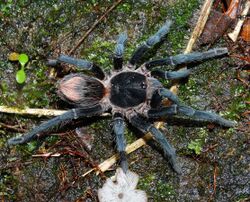Biology:Homoeomma
| Homoeomma | |
|---|---|

| |
| Scientific classification | |
| Domain: | Eukaryota |
| Kingdom: | Animalia |
| Phylum: | Arthropoda |
| Subphylum: | Chelicerata |
| Class: | Arachnida |
| Order: | Araneae |
| Infraorder: | Mygalomorphae |
| Family: | Theraphosidae |
| Genus: | Homoeomma Ausserer, 1871[1] |
| Type species | |
| H. stradlingi O. Pickard-Cambridge, 1881
| |
| Species | |
|
13, see text | |
| Synonyms[1] | |
Homoeomma is a genus of South American tarantulas that was first described by Anton Ausserer in 1871.[5] It is considered a senior synonym of Calopelma,[3] Butantania,[2] and of Cyclothoracoides.[4] These tarantulas are usually quite small and usually burrow a few centimeters under a rock or log.[6]
Diagnosis
Males of this genus can be distinguished by the tile-like apophysis on the base of the palpal bulb, and the embolus being in an obtuse angle, in relation to the bulb. Males also have a flexion of the metatarsus 1, which is between the branches of the tibial apophysis. Females can be distinguished by the spermatheca morphology, which lacks constriction in the apex.[6]
Species
(As of August 2022) it contains thirteen species, found in South America:[1]
- Homoeomma brasilianum (Chamberlin, 1917) – Brazil
- Homoeomma chilense Montenegro & Aguilera, 2018 – Chile
- Homoeomma elegans (Gerschman & Schiapelli, 1958) – Argentina
- Homoeomma familiare Bertkau, 1880 – Brazil
- Homoeomma hirsutum (Mello-Leitão, 1935) – Brazil
- Homoeomma montanum (Mello-Leitão, 1923) – Brazil
- Homoeomma nigrum (Walckenaer, 1837) – Brazil
- Homoeomma orellanai Montenegro & Aguilera, 2018 – Chile
- Homoeomma peruvianum (Chamberlin, 1916) – Peru
- Homoeomma strabo (Simon, 1892) – Colombia, Brazil
- Homoeomma stradlingi O. Pickard-Cambridge, 1881 (type) – Brazil
- Homoeomma uruguayense (Mello-Leitão, 1946) – Uruguay, Argentina
- Homoeomma villosum (Keyserling, 1891) – Brazil
In synonymy
- H. bicolor Sherwood, Gabriel & Longhorn, 2018 = Homoeomma chilense Montenegro & Aguilera, 2018
- H. cyclothorax (Mello-Leitão, 1923) = Homoeomma montanum (Mello-Leitão, 1923)
- H. moreirae (Mello-Leitão, 1923) = Homoeomma brasilianum (Chamberlin, 1917)
- H. regina (Chamberlin, 1917) = Homoeomma strabo (Simon, 1892)
- H. serratum (Gerschman & Schiapelli, 1958) = Homoeomma uruguayense (Mello-Leitão, 1946)
Transferred to other genera
- Homoeomma alcirae Gerschman & Schiapelli, 1954 → Plesiopelma alcirae
- Homoeomma humile Vellard, 1924 → Bumba humilis
- Homoeomma pictum (Pocock, 1903) → Anqasha picta'
- Homoeomma simoni Soares & Camargo, 1948 → Catanduba simoni
See also
References
- ↑ 1.0 1.1 1.2 Gloor, Daniel; Nentwig, Wolfgang; Blick, Theo; Kropf, Christian (2022). Gen. Homoeomma Ausserer, 1871. Natural History Museum Bern. doi:10.24436/2. http://www.wsc.nmbe.ch/genus/3372. Retrieved 12 February 2022.
- ↑ 2.0 2.1 Pérez-Miles, F. (1996). "Systematic revision and cladistic analysis of Theraphosinae (Araneae: Theraphosidae)". Mygalomorph 1: 52.
- ↑ 3.0 3.1 Gerschman de P., B. S.; Schiapelli, R. D. (1972). "El género Homoeomma Ausserer 1871 (Araneae: Theraphosidae)". Physis, Revista de la Sociedad Argentina de Ciencias Naturales 31: 241.
- ↑ 4.0 4.1 Lucas, S. M.; Indicatti, R. P. (2015). "Revalidation of Dolichothele Mello-Leitão and notes on Hapalotremus Simon (Araneae, Mygalomorphae, Theraphosidae)". Studies on Neotropical Fauna and Environment 50 (3): 210. doi:10.1080/01650521.2015.1103553.
- ↑ Ausserer, A. (1871). "Beiträge zur Kenntniss der Arachniden-Familie der Territelariae Thorell (Mygalidae Autor)". Verhandlungen der Kaiserlich-Königlichen Zoologisch-Botanischen Gesellschaft in Wien 21: 117–224.
- ↑ 6.0 6.1 Montenegro, Rubén; A. Aguilera, Milenko; Casanueva, María Eugenia (2018). "First record of Homoeomma Ausserer, 1871 in Chile and description of two new species". https://www.researchgate.net/publication/329483842.
Wikidata ☰ Q2715716 entry
 |

